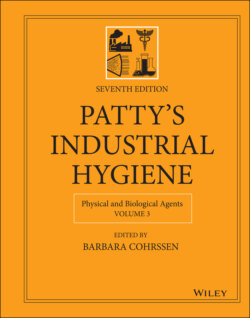Читать книгу Patty's Industrial Hygiene, Physical and Biological Agents - Группа авторов - Страница 87
4.5 Newer Conditional Classes 1M and 2M
ОглавлениеIn 2000, the world safety community began to recognize the need to make some minor revisions in the traditional laser classification systems, with the creation of a Class 1M and Class 2M and expand Class 3R for greater consistency in dealing with the potential for optically aided viewing. Telescopes can greatly increase the hazard of intra‐beam viewing of the beam at a great distance. In this case, a standardized 50‐mm aperture is assumed to collect a collimated beam at a distance (e.g. a 7 × 50 binocular), rather than the usual 7‐mm aperture to simulate the pupil size for a dark‐adapted eye. The IEC standard also assumed a Class 1M and Class 2M condition for viewing a highly diverging beam – if from a fiber‐optic – with an eye‐loupe or magnifier. The eye‐loupe viewing risk was never considered a realist risk for the ANSI Z136 standards, except in the application‐specific, or “vertical” standard, ANSI Z136.2, Safe Use of Lasers in Optical Communication Systems.
The addition of those newer classes recognized the value of having conditional classes. Another proposal that met with some favor for dermatological lasers was the IEC Class 1C conditional class for skin‐treatment lasers that only fire when in firm contact with the skin. Technically the skin‐treatment lasers cannot be considered in Class 1, even if the eye is always protected, since the skin is exposed above skin ELs. There are industrial material‐processing lasers that are Class 4 but are considered technically Class 1 because they will only emit when in firm contact with the surface being treated. In this case, the treated surface is considered part of the protective housing.
The subject of still further refinements sometimes arises in standards committees. From time to time, there have been efforts in laser standards committees to “update” or “improve” the classification of some Class 3 eye‐hazardous lasers and the most hazardous lasers (Class 4). Proposals are normally to insert additional classes based upon a concept that hazards increase gradually and the dynamic range of Class 3B can be a factor of 100‐fold. However, past efforts to refine and sophisticate the classification system have been voted down because they added complexity, where simplicity was desired. The value could only be if they indicated different control measures. For the user, the class achieves the first step of hazard evaluation with the indication of appropriate control measures without the need to consult a laser safety advisor (LSA) or LSO.
If a high‐power, Class 4 laser is partially enclosed such that the risk of occupational exposure is very low, the level of control can be greatly reduced, but it is not necessary to invent another “conditionally safe” class. It is best to try to educate people that Class 4 does not necessarily imply a serious risk and that the controls adopted should be appropriate to the circumstances, rather than defining a new class for “conditionally safe” products. The current system of classification is based on the level of hazard with only an implication for the degree of risk, and this is the basis of the recommendations given in user guidelines. The class indicates the potential hazard of the product, but the actual risk is not fully defined by the class, since it depends on the environment in which it is located and the people potentially exposed. For example, a high‐power, Class 4 industrial, material‐processing laser that is Class 4 because the enclosure does not have a fully light‐tight enclosure, and perhaps does not have a roof could be quite acceptable in locations where the ceiling is close to the enclosure, but not in another location where there are walkways at a higher level that provide a direct view into the enclosure. In a user safety standard, the laser safety expert might classify the enclosure adequate for Class 1, but the manufacturer might have to retain the Class 4 label, since the system could be installed in any location. ANSI Z136.1 incorporates the concept of greatly relaxed control measures when Class 1 conditions exist and the hazardous area is very small or inaccessible.
